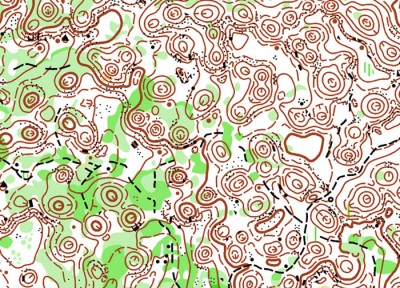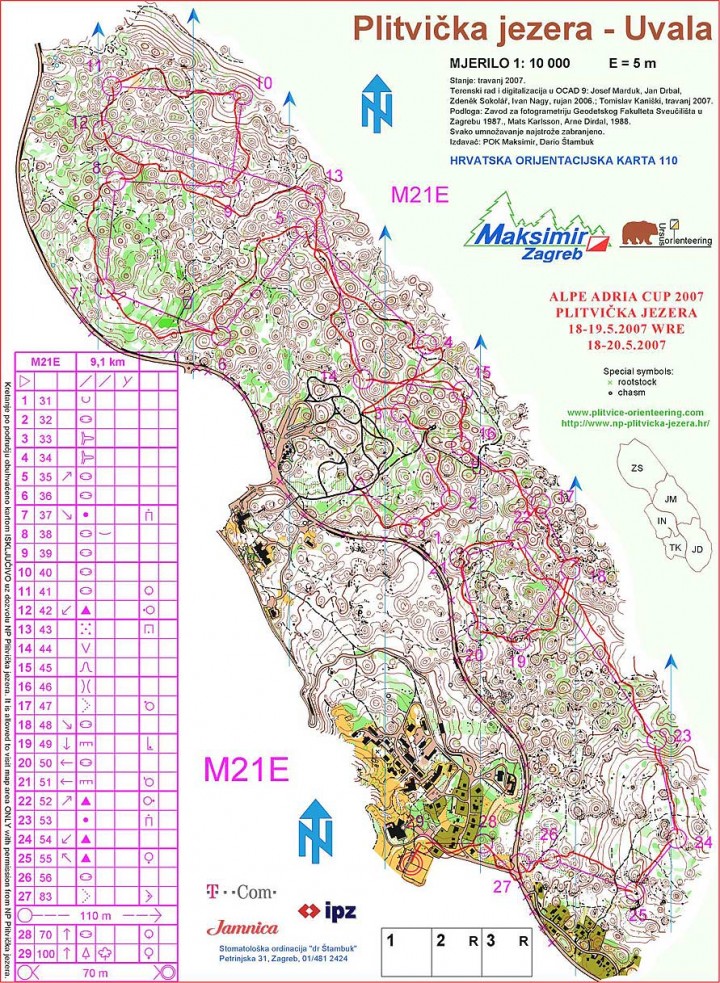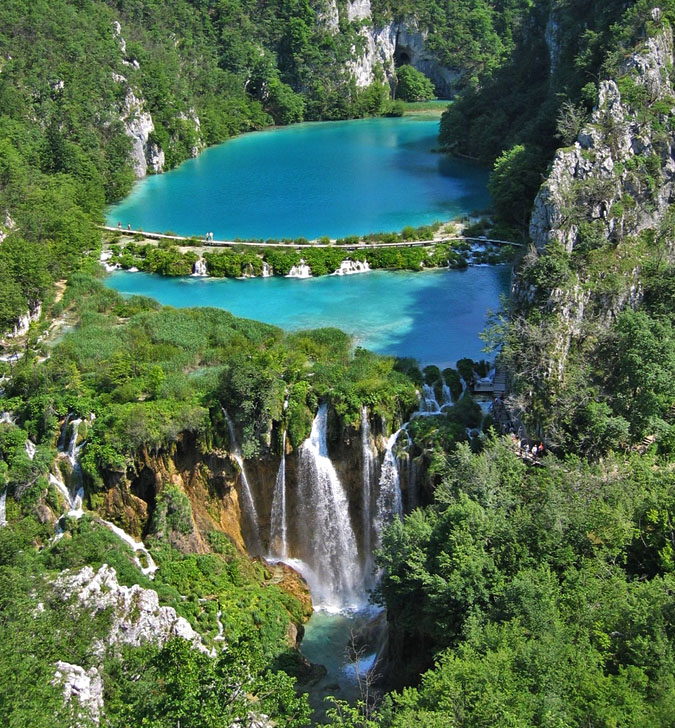Plitvička jezera
Hidden in the middle of deep forests of Lika region in Croatia, Plitvice lakes are one of the Europe’s top natural attractions. Thousands of tourists vist this National park every year, but did you know that just a few steps off of the main paths there is a real wilderness, an orienteers’ treat at its best?
On Darko Sakar’s (OK Maksimir, Zagreb) initiative in 1988 the first orienteering map of Plitvice was made by Arne Dirdal and Mats Karlsson, however, it was not before 18 years later that the first competition was actually organized there. In the period 2006 – 2007 a part of the map was renewed by Slovenian-Croatian and Czech mappers. This time it was Dario Štambuk, a Zagreb based dentist and a keen orienteer, who decided to revive the Plitvice project. I happened to be one of the lucky guys invited for mapping.
Strong similarity of relief features
Despite some heavy rains and cold hands during my stay in Plitvice, mapping of the area was fun, though I have to admit that running on the unknown part of the map made by Czech mappers was even far better. The main challenge of the area is the lack of paths, occasionally greenish vegetation which hinders visibility and above all a strong similarity of relief features. You lose map contact once, and most likely you will end up with a bad race. The fastest way to navigate through this area is to use the gentle ridges and flat hill tops between depressions as kind of line objects whenever you can. A skilled course planner will try to make this hardly possible, though.

The faster type of forest on Plitvička jezera map. This particular area has been used a few times for Sprint races.
Why should you run on this map before you die?
So why did we choose this map as a candidate for 101 maps you should run on before you die? Mainly because of the quality of terrain, but also because of the beauty of this very special place. Plitvice lakes are UNESCO protected and as corny as it may sound they really are something you should see. Not only because of unique waterscape, but also for the fact that the forests that surround the lakes kept their truly wild spirit – isn’t it exciting to know that the more remote parts of this big National park are still inhabited by the rare specieses like wolf (Canis Lupus), bear (Ursus arctos) and the bobcat (Lynx lynx)?
(Article continues below the pictures.)
Photo: http://www.flickr.com/photos/oaklandnative/ / CC BY-NC 2.0
| Map: | Plitvička jezera |
|---|---|
| Scale: | 1: 10000 |
| Equidistance: | 5m |
| Year: | 1988, partly renewed in 2006-2007 |
| Size of map: | old map cca. 12km2, new map cca. 3km2 |
| Mappers: | 1988: Arne Dirdal and Mats Karlsson, 2006-2007: Ivan Nagy, Tomislav Kaniški, Ondřej Dostál (under the pseudonym Josef Marduk), Jan Drbal, Zdeněk Sokolář |
| Terrain type: | Karst terrain, stony, many depressions, in places low visibility |
| Estimated top speed: | 7min/km |
| Interesting points: | The mapped area itself is hundreds of years old beech forest. Walking distance from the map it is possible to reach astonishing waterfall landscape and emerald green lakes. |
| Links of interest: | whole map at low resolution, OK Maksimir (the owning club), Plitvice lakes national park |
| Events on map: | Alpe Adria cup, Maksimir cup |
| Country: | Croatia |
| Location: |
Discussion
Please note that the map being presented in this article does not necessarily mean that it will also be included in the final selection of the 101 maps – and in the paper book. It only means it is currently on our candidate list. Please use the comment field below to give us your opinion about the map.
Why should/shouldn’t this map be on the list of the 101 maps? Do you know about another map with similar characteristics which should be chosen instead? Have you ever run on this map?




It seems that the first map presented is a real surprise for most of you as it was not mentioned in yesterdays comments/suggestions (and there were quite a few). If you look carefully at the blog’s banner there was a little hint about it :)!
Well, this means that at this time nobody wins a free copy of the paper book, but be sure there will be another chance.
All your comments are still highly appreciated. About the map, your suggested areas, the way you would like artciles to be written …!
… but still the poll for now shows that 95% think that this is a good choice for the selection of the 101 Orienteering Maps you should run on before you die. So I guess Ivan digged out a small gem here which not too many were already aware of. We’ll find more of these, I’m sure…
Estimated top speed for the map – is this the estimated speed for the orienteering course or really the real average speed we could get from the actual distance covered?
Good question Renars. Estimated top speed is meant as an estimation (!) of average speed of top orienteers on this particular map. Of course this depends on many things – course planning being one of the most important of them. This particular course was won by Markus Lang with speed 8.4 min/km. My estimation is that the very top runners on important competition would do considerably better than that (even if 8.4min/km on such terrain is very good).
The estimated speed is not meant as some exact measure, but more for the readers to get a feeling of how fast/slow the terrain is.
This orienteering video is partly made in the area of this map:
http://www.youtube.com/watch?v=4hWCBssvIDQ
i come from croatia, and am an orienteerer for 15 years, i knew about the map, because i ran on it for few times, the map came imidietly across my mind when discussing the most interesting terrains to run on. but i newer thought somebody would put it as number one, because it’s quite hidden attraction. there were no bigger competitions on it, by big i mean 1000 or more competitors. what is quite nice about this terrain, is that this is old forest which means that you can see more than 100m ahead, the depressions are big and pretty deep, there you get that feeling as you were on some other planet, moon like but with forest. something exceptional indeed, i ran on many different terrains, and this one had that special feeling, because everything is so big, but in the same time detailed which makes you focused, it’s an unique feeling one should really feel at least once in his lifetime.
Thanks a lot for describing more in detail how it is to really run on the map. It makes me want to go there even more:) And this feeling you are talking about is exactly one of the criteria I think is important for choosing maps for the 101 maps list.
That said, we’ve not said that this map is number one – we’ve just put it up as a candidate for the list. It will probably make the final selection list – but that’s all we can say for now.
Plitvicka-jezera Google Earth locator
http://idrett.speaker.no/Downloads/62050/docs/Plitvice.kmz
Thanks Tibor, but the link does not seem to work? Anyway, we plan to make a Google Earth compatible view of the presented maps in due time – so you’ll get all in one place.
the ”unique feeling” also reminded me on the map rock paradise from southern germany. the many but nicely looking rocks are quite a beutifull look, and at some parts you also get that special i am on some other planet feeling, just like in plitvice. the difference is that this happens occasionally on rock paradise, but on plitvice it’s the feeling that gets you with the firs forest step till the end of the race.
Have you got more information about the map “Rock Paradise” in southern Germany? Location? Maybe a map sample?
on german it’s called felsen paradies, the map is in bavaria, regensburg. it was a host for the last years alpe adria cup, when you look at the map it doesn’t seem that spectacular but the terrain itself is really a rock paradise. here is the link: http://2.bp.blogspot.com/_5GEBHwc6jz8/SgDEC2Q0QJI/AAAAAAAAAN4/NU00YciES08/s1600/Regensburg%2BMittelroute.jpg
Thanks, Adem. It looks like a nice map – not sure if it will make it on the list though. I think there are many terrains in Czech Republic / Saxony that are even more interesting regarding the rocky details?
there aren’t any small stones on the ground so it’s quite runnable and the forest is nice it isn’t bushy, there are only big rocks, which are granite i think, so the look really nice.
isfallet, the southernmost map of the world. drawn by a swedish antarctica expedition, probably with some guys from järfälla ok, because its listed on their site.
http://hem.passagen.se/jokol_b/kartor/Isfallet.gif
-74°34′41”, -11°02′15”
I’m not sure about the coordinates on the map, because I couldn’t really locate it on google earth, but it might also be that the program isn’t 100% accurate.
the fact that it’s the southernmost map is maybe more exciting than the map itself, but I thought it fits into the context ;)
sorry, posted it into the wrong place…
[...] objavili i knjigu o tome. Karta Plitvica je odabrana kao jedna među prvima. Više pogledajte na službenim stranicama bloga! Share and [...]
Nice to see the Plitvica map in print! I spent one week in 1987 helping to finish the first version of the map. A really magnificent area! If I remember correcly is was not as straight forward as it is today to let two foreigners handle a detailed map (it was still Jugoslavia in those days). Anyone who have a copy of the first version of the map? If it ever got printed…
As one of the mapmakers in 2006 and 2007, I can only confirm that the terrain is great! Just to refine: in October 2007, the map displayed here was enlarged on the southern edge by Zdeněk Sokolář, Jan Drbal (me) and Roman Horký – a new member of the team.
Now there are some pics from the mapping and samples of my part of the map and basemaps at http://www.holidaymappers.eu/en/index.php?page=plitvice. And here http://www.holidaymappers.eu/en/index.php?page=plitvicejezera is our small map with some of the Plitvice lakes.
Thanks a lot for the info and links, Jan. Great to get some insight into how the mapping is done.